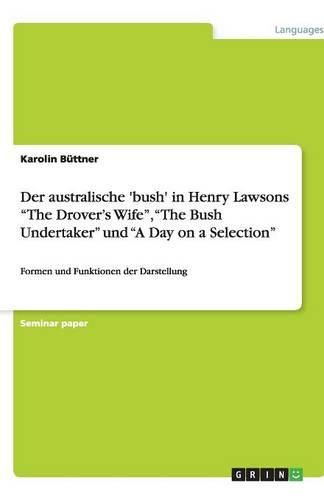Readings Newsletter
Become a Readings Member to make your shopping experience even easier.
Sign in or sign up for free!
You’re not far away from qualifying for FREE standard shipping within Australia
You’ve qualified for FREE standard shipping within Australia
The cart is loading…






Seminar paper from the year 2008 in the subject English - Literature, Works, grade: 1,3, University of Cologne (Philosophische Fakultat, Englisches Seminar), course: Australian Literature in English in the Colonial Period, language: English, abstract: Bush is a term which probably derives from the Dutch word bosch’ and was used as early as 1800. By the 1820s it was in common use to denote the unsettled areas of the Colony and, more specifically, as the Australian equivalent of the English words ‘woods’ and ‘forest’. Although many early settlers disliked and feared the bush, it did not go completely unpraised (Wilde et. al. 1994: 128f.). However, early complaints about the sombreness of the bush were strengthened by the many tragedies that befell the explorers and pioneers in their efforts to chart and settle it (ibid. 129). The loneliness of the bush was mentioned also. When Adam Lindsay Gordon describes, in his preface to Sea Spray and Smoke Drift, the dominant note of the Australian bush as one of ‘weird melancholy’ and the bush itself as ‘funereal, secret, stern’, he is reflecting the view that persisted for most of the first century of white settlement (ibid. 129). With the 1890s and the upsurge of nationalism and, through works of writers such as Henry Lawson (1867 - 1922), the bush comes to be viewed as a major shaping instrument of the Australian national spirit and outlook (ibid. 129). This notion of the bush was developed further. Literature was now eager to show the mystique of the bush, a sense that it was a sa-cred, inspiring power, influencing for good, both individual and nation (ibid. 129). But the focus was not only on the things mentioned so far but also on the bush people and their lives. [T]he bushman stereotype emerges as a rugged, versatile individualist, cheerful, laconic, philosophical in the face of hardship, independent in his own troubles but generous and loyal to his mates and others who need help (ibid. 129f.). Life of the b
$9.00 standard shipping within Australia
FREE standard shipping within Australia for orders over $100.00
Express & International shipping calculated at checkout
Seminar paper from the year 2008 in the subject English - Literature, Works, grade: 1,3, University of Cologne (Philosophische Fakultat, Englisches Seminar), course: Australian Literature in English in the Colonial Period, language: English, abstract: Bush is a term which probably derives from the Dutch word bosch’ and was used as early as 1800. By the 1820s it was in common use to denote the unsettled areas of the Colony and, more specifically, as the Australian equivalent of the English words ‘woods’ and ‘forest’. Although many early settlers disliked and feared the bush, it did not go completely unpraised (Wilde et. al. 1994: 128f.). However, early complaints about the sombreness of the bush were strengthened by the many tragedies that befell the explorers and pioneers in their efforts to chart and settle it (ibid. 129). The loneliness of the bush was mentioned also. When Adam Lindsay Gordon describes, in his preface to Sea Spray and Smoke Drift, the dominant note of the Australian bush as one of ‘weird melancholy’ and the bush itself as ‘funereal, secret, stern’, he is reflecting the view that persisted for most of the first century of white settlement (ibid. 129). With the 1890s and the upsurge of nationalism and, through works of writers such as Henry Lawson (1867 - 1922), the bush comes to be viewed as a major shaping instrument of the Australian national spirit and outlook (ibid. 129). This notion of the bush was developed further. Literature was now eager to show the mystique of the bush, a sense that it was a sa-cred, inspiring power, influencing for good, both individual and nation (ibid. 129). But the focus was not only on the things mentioned so far but also on the bush people and their lives. [T]he bushman stereotype emerges as a rugged, versatile individualist, cheerful, laconic, philosophical in the face of hardship, independent in his own troubles but generous and loyal to his mates and others who need help (ibid. 129f.). Life of the b